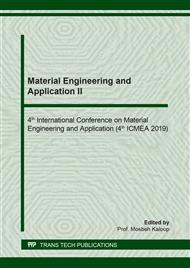p.3
p.9
p.14
p.20
p.26
p.36
p.41
p.48
Development of a TAPE-Agar Liquid Gel Bandage
Abstract:
In this study, a liquid gel bandage for wound treatment was synthesized using a combination of tannic acid and polyethylene glycol (TAPE). Agar was added as a stabilizer based on the physical properties of the formed product. Ethanol was chosen as solvent based on the resulting drying rate and mixing consistency. The liquid bandage was characterized in terms of its drying, adhesion, and swelling. Also, its antimicrobial and cytotoxic properties were evaluated. The final formulation had a drying time of 5 minutes, a T-peel adhesion yield point of 591.6 Pa, and a swelling ratio of 64%. The gel was also observed to be anti-microbial towards both S. aureus and E. coli, as well as exhibiting cytotoxic effects. Overall, the gel proved to have comparable properties to previously studied liquid bandages yet can be produced at a significantly lower cost.
Info:
Periodical:
Pages:
20-25
Citation:
Online since:
May 2020
Keywords:
Price:
Сopyright:
© 2020 Trans Tech Publications Ltd. All Rights Reserved
Share:
Citation:


